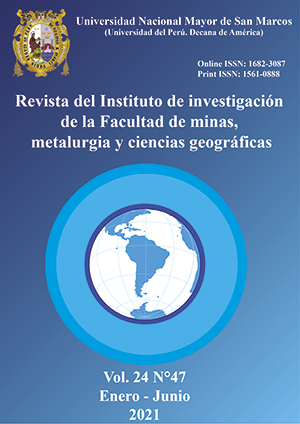Huaraz city urban growth modeling through logistic regression
DOI:
https://doi.org/10.15381/iigeo.v24i47.20644Keywords:
Urban growth, logistic regression, geomatic, spatial trend, HuarazAbstract
In 1941, Huaraz city was affected by a flood from Palcacocha glacier lagoon, thenceforth the city grew significantly occupying areas exposed to floods. For future risks analysis, city growth prospective evaluation is necessary, being logistic regression a widely used technique. Using geomatic tools, aerial and satellite photographs from 1948, 1962, 1977, 2011 and 2018 were visually and geometrically corrected taking cadastral map 1:10,000 as base cartography. With complementary field work polygons of urban/populated areas were obtained within a 25 km² analysis zone, with which the historical spatial trend and growth characteristics were analyzed in relation to variables such slope, altitude, distance from city middle center, direction growth and point density; which were used as independent variables in the regression logistic model being the dependent the 2018 urban/populated coverage. Between 1948 and 2018 Huaraz grew 598% in South-North direction with bias towards East. Excluding 2018 urban/populated area, 21% of the analysis zone has probabilities of housing new urban/populated areas greater than 0.2, prevailing 0.2 to 0.4 probabilities with 11%.
Downloads
Published
Issue
Section
License
Copyright (c) 2021 Ricardo Ray Villanueva Ramírez, Carlos Del Valle Jurado

This work is licensed under a Creative Commons Attribution 4.0 International License.
AUTHORS RETAIN THEIR RIGHTS:
a. Authors retain their trade mark rights and patent, and also on any process or procedure described in the article.
b. Authors retain their right to share, copy, distribute, perform and publicly communicate their article (eg, to place their article in an institutional repository or publish it in a book), with an acknowledgment of its initial publication in the Rev. Inst. investig. Fac. minas metal cienc. geogr.
c. Authors retain theirs right to make a subsequent publication of their work, to use the article or any part thereof (eg a compilation of his papers, lecture notes, thesis, or a book), always indicating the source of publication (the originator of the work, journal, volume, number and date).






